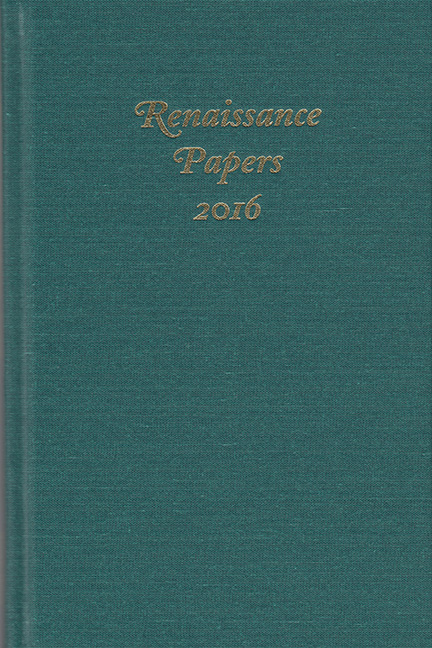Book contents
- Frontmatter
- Contents
- Renaissance Papers
- Beyond Recognition: Mutilation, Marginalia, and the Vicissitudes of Reading
- Velázquez as Reader and the Pictor Doctus in Early Modern Spanish Art
- “Out of this silence yet I picked a welcome”: The Audience in A Midsummer Night's Dream
- Uncommon Justice: The Secret Knowledge and Sagacious Judgment of Old Escalus
- Boundaries in a Globalized World: Shakespeare's Antony and Cleopatra
- Imitation, Innovation, and Imperium: The Grammar School Education of Lear's Daughters
- Violent Brothers, Deadly Antifeminism, and Social Suicide in The Revenger's Tragedy and The Duchess of Malfi
- Canon Fodder: Notes on Don Quijote
Velázquez as Reader and the Pictor Doctus in Early Modern Spanish Art
Published online by Cambridge University Press: 23 August 2019
- Frontmatter
- Contents
- Renaissance Papers
- Beyond Recognition: Mutilation, Marginalia, and the Vicissitudes of Reading
- Velázquez as Reader and the Pictor Doctus in Early Modern Spanish Art
- “Out of this silence yet I picked a welcome”: The Audience in A Midsummer Night's Dream
- Uncommon Justice: The Secret Knowledge and Sagacious Judgment of Old Escalus
- Boundaries in a Globalized World: Shakespeare's Antony and Cleopatra
- Imitation, Innovation, and Imperium: The Grammar School Education of Lear's Daughters
- Violent Brothers, Deadly Antifeminism, and Social Suicide in The Revenger's Tragedy and The Duchess of Malfi
- Canon Fodder: Notes on Don Quijote
Summary
Introduction
DIEGO Velázquez (1599–1660) is generally regarded as the greatest painter of seventeenth-century Spain. He is celebrated for elevating the status of art to an honorable endeavor and that of the artist to a nobleman as seen in his extraordinary self-portrait, Las Meninas (The Maids of Honor; fig. 1). While the cultural contexts of Velázquez's formative years in Seville and mature career at Philip IV's court in Madrid have been the subjects of important publications, many questions remain to be addressed about Velázquez's intellectual life. Published documents relating to Velázquez's later years in Madrid primarily pertain to his handling of the logistics of the court in his administrative capacity as aposentador (or court chamberlain) and tell scholars very little about the painter's views on art. The prevailing image of Velázquez in the art historical literature is that of a painter and courtier, whose social climbing paradoxically curtailed his artistic production.
Velázquez's persona as a reader and thinker, however, warrants fuller discussion. Cultural historian José Antonio Maravall placed Velázquez in the intellectual world of the seventeenth century but without much regard to how the artist's style reflected his complex ideas. In reconsidering the erudite aspects of Velázquez's art, the inventory of his library is perhaps the sole document that concretely identifies the varied printed sources that shaped his ideas. On August 18, 1660, twelve days after the artist's death, the Madrilean notary Juan de Burgos drew up an inventory at the request of the nobleman and secretary of the treasury Gaspar de Fuensalida and the painter Juan Bautista Martínez del Mazo, Velázquez's son-in-law. These books were among the possessions that Velázquez kept in his apartment in the Casa del Tesoro within the royal complex of the Alcazár, the interior of which is represented in del Mazo's family portrait, The Artist's Family (1659–60; Oil on canvas, Kunsthistorisches Museum, Vienna).
Currently housed in the Archivo Historico de Protocolos in Madrid, the actual inventory of Velázquez's library was first located by Francisco Marin, an archivist at the Biblioteca Nacional de Madrid, who presented his findings during a lecture on Velázquez's mentor, Francisco Pacheco. Thereafter, it was published in 1925 by art historian Francisco Javier Sánchez Cánton.
- Type
- Chapter
- Information
- Renaissance Papers 2016 , pp. 15 - 30Publisher: Boydell & BrewerPrint publication year: 2017



